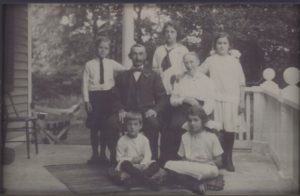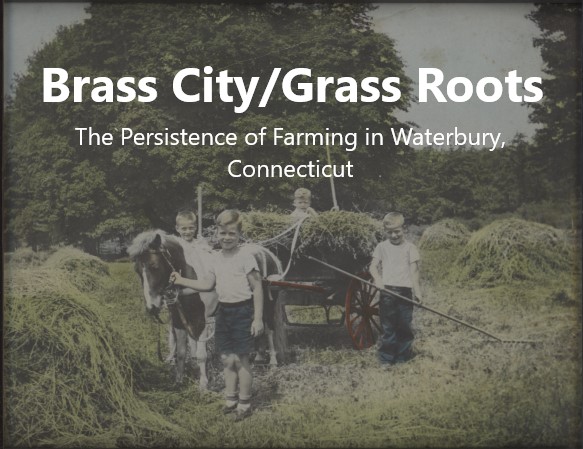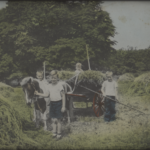This article is part of the digital exhibit Brass City/Grass Roots: The Persistence of Farming in Waterbury, Connecticut. Use the arrows at the bottom of the page to navigate to other parts of the exhibit.
“Farming isn’t a job. It’s a way of life.”
—Bill Pierpont
Revolutionary War veteran Ezra Pierpont came to Waterbury’s East Farms district, eventually splitting his extensive land holdings among his five sons. Pierponts were involved not just in farming but in peddling their farm products as butchers, milk dealers, and grocers. Their meat wagons and milk trucks plied the dense inner-city neighborhoods where first the Irish factory workers lived, then the Eastern and Southern Europeans of the later immigration stream. In fact, Enos Pierpont, Ezra’s grandson, may have been Waterbury’s first butcher.
You can see several Pierpont land parcels on the 1874 map [Panel 2] Enos Pierpont’s farm had 400 acres in the 1870 census, a giant tract by the standards of the time and place. Enos’ nephew Austin B. Pierpont had (in 1880) a more modest 115 acres, including 10 tilled acres, 30 in meadows, pastures, and orchards, and 25 in woodlands. He had 2 horses, 2 working oxen, 11 “milch cows” and other livestock. In 1879 he had sold some 6,000 gallons of milk to factories to make butter and cheese and had 175 pounds of butter and 150 pounds of cheese made on his farm. Fifty chickens yielded 300 eggs. The farm grew “Indian corn,” oats, and rye and produced 20 pounds of maple sugar, 200 bushels of potatoes, 150 bushels of apples, and 5 cords of wood.

Pierpont family portrait: Austin B. and Lucy Welton Pierpont on their porch with their 5 grandchildren, Hazel, Helen, Marion, Ralph, and Lawrence. The boys also became farmers. – Photo courtesy of Bill Pierpont, click to enlarge
Austin Pierpont and his descendants were in the forefront of 19th and 20th century state and regional movements to use farm organizations, better education, and new technology to keep local agriculture viable in the face of increasing Western competition. Austin was one of the first farmers in Connecticut to adopt Holstein-Friesians, cows specifically developed for dairying. His children and grandchildren went to the Connecticut Agricultural School, later known as the University of Connecticut. Family members were active in many farming organizations, serving on the state board of agriculture, the Connecticut Dairymen’s Association, and the Connecticut Pomological Society. Their apples and livestock routinely won prizes at Connecticut’s agricultural fairs. In the early to mid-20th century, Pierponts were active in state and city dairy cooperatives that tried to keep dairy farmers in business through collective marketing and fair pricing.
- Panorama of Maple Hill Farm: This aerial photo of Maple Hill Farm was taken in the 1950s. The street in the foreground is East Main, with Pierpont Road on the right side alongside the cluster of barns – Photo courtesy of Bill Pierpont, click to enlarge
- Maple Dairy Farm calendar: Every year the Pierpont Maple Dairy Farm published a calendar which they would distribute to customers. This colorized picture from the 1946 calendar features Peter and James Pierpont in front, William and David Pierpont in back. When the farm ceased operations in the 1970s, David took the remaining cows and started a new farm in Vermont – Photo courtesy of Bill Pierpont, click to enlarge
The Pierponts are an example of how a family could successfully farm for centuries and not only co-exist with industry but also benefit from it. Industry brought an urban density of customers; it also brought new machinery, breeding practices, and techniques that helped small farmers. But modernization was a double-edged sword, which became increasingly apparent as the 20th century wore on.
Note: ConnecticutHistory.org does not edit content originally published on another platform and therefore does not update any instances of outdated content or language.
<< Previous – Home – Next >>











